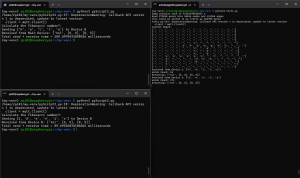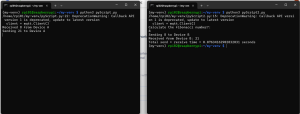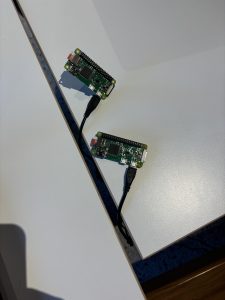This week, we gave our presentation on Monday, and then I worked the rest of the week on setting up all of the screens so that they can all be running at once as well as the game state manager. At this point, besides creating the hardware, almost all of our time will be for integration and debugging. We will also create the poster and the demo materials. We are on pace to complete the project by Friday
Denis’s Status Report for 11/23-11/30
The past couple weeks I’ve focused my time into integrating the different individual elements of our project as well as some of the smaller tasks that our project needs.
A major thing over the past couple weeks has been configuring our touch screens and creating scripts that will run on our raspberry Pi 0s and the Raspberry Pi 4. This was very difficult and took a lot of debugging and troubleshooting. However, we now have a consistent setup and are able to get the touch screen working almost every time. We will replicate this setup across the other 3 raspberry pi 0s.
We also designed a casing for the screens to contain the battery packs and converters.
I believe that we are on pace for the final demo and will be in a good place for the rest of the semester.
I gained a lot of skills throughout the semester, both clearly defined technical skills as well as softer problem-solving skills. I got the chance to work with new python modules, and a new protocol in MQTT. Learning about something like a new protocol and considering the tradeoffs of different options was a good exercise in design. Another good experience was debugging the LCD touchscreens, as encountering a snag like that, without a clear solution was a good chance to practice troubleshooting. Having to look through the boot logs and looking through old forums was definitely a learning experience.
Denis’s Status report for 11/16
This week I began creating our battery packs to make the Raspberry Pi 0s portable. Right now, they are very cumbersome because the wiring isn’t done well, but as a proof of concept they are fine for right now. For the final demo, they will be soldered and much more compact.
Also, I began working with the touchscreens as they were delivered this week. As of right now we are struggling to get the touchscreens to display the GUI and begin writing an application for the user input. We hope to have some sort of user input for the demo. I will be working a lot on Sunday to get this working and will provide an update of how far I get with it.
As of right now, I believe I am on pace for completing the project, and definitely on pace for having a successful demo
Denis’s Status Report for 11/9
This week I began working with the main RPI4 board, and having that work as the main communication hub. I set up the RPI 0s to send messages to the hub and the RPI4 to process these and send back messages. For all MQTT communication we will use a format similar to this, sending arrays between the devices.
- Index 0: Sender ID
- Index 1: Receiver ID
- Index 2: Task ID
- Index 3-end: Data
As an example, sending a tile rack from device 1 to the main device could look like this:
[1,0,0,”d”,”e”,”n”,”i”,”s”]
As a final thing to do this week, I added the hint logic and began running that off of the main pi, sending a tile rack from the RPI0 to the main board, counting all the possible words and sending back one of the words for now.
For next week, I’m hoping to begin working on the portable powering and the touchscreens. I feel pretty on schedule, but I’m worried I could fall behind at any point.
Team Status Report for 11/2
This week we made big strides with the hardware components of the project, getting 2 raspberry pi 0s to communicate with each other. We are waiting on a couple more parts to come in, which are holding us up right now. That is currently a big risk, but we are trying to mitigate that by developing as much as possible around that, including writing a thorough skeleton code for each of the RPi’s.

Denis Status Report for 11/2
This week I was able to make strides forward with the hardware components of the project. The biggest step was getting two Raspberry Pi’s communicating with each other and sending data back and forth. I also moved them from my home WiFi to CMU-Device, which will be important for the demos. I was hoping to also start working with the LCD touchscreens but they have not come in yet, I think that I filled out the form too late.
In this next week, I would like to begin working with the touchscreens and developing the program that will be running on each of the RPI0s. I would also like to begin working on the battery packs that will be powering the Rpis. I would say that I am slightly behind schedule but should be able to easily catch up provided that the hardware comes in this week. I am also planning on designing the case that we will be putting the RPi 0 and the batteries into.


Denis Status Report for 10/26
I did not have as much time as I anticipated this week outside of the ethics assignment, but still managed to get a little bit of progress towards the hardware side of the project. I have a single Raspberry Pi sending messages to my laptop, on a timer. Hopefully, by the end of the weekend I will have the RPi receiving a similar message and flashing a light or some sore of signal to prove that it’s been received.
For this upcoming week, I need to have 2 RPi’s commnicating with each other. As soon as I have that I will pivot to working on the LCD touchscreens, beginning with a static image of what we want it to look like and then working to a dynamic set up where the user can press a button and then see the signal appear on the other RPi.
I would say that I’ve fallen slightly behind schedule, however this next week should be free enough for me to catch back up.
Denis’s Status Report for 10/19
This past week I spent the majority of my time working on the design report. I wrote most of the second half of the design report, asking my groupmates the specifics of their parts of the implementation. This upcoming week, I’ll begin working with the RPi0s, and my goal is to have them communicating using MQTT by next Saturday. I think that individually and as a group we are on pace to complete our project, but our next 2-3 weeks will be very important for the success of our project.
Denis’s Status Report for 10/5
This week I researched the specific RPi models and LCD screens that we should use for our project. I also began looking into the MQTT protocol and how that can be implemented on the RPis. This upcoming week, I plan on beginning to interface and send data between 2 RPis as well as beginning to create an interface that we’ll be able to use on the LCD screens. My plan is to create a mock-up for what we want the screens to look like, and ensure that we can receive an input from the touch screen. We are on pace for our project.
Team Status Report for 9/28
This week, we primarily focused on our design presentation. We refined our design, moving away from a wired FPGA implementation to a wireless approach. To accomplish this, we plan to use Raspberry Pi 0’s for each of the displays (one per player, plus a main display) to communicate with the primary RPi, which will handle most of the computation. MQTT and HTTP Rest APIs are the two primary approaches we are currently considering, with the former being our current planned approach.
A was written by Jolie Wasserman, B was written by Cody Breidenbach and C was written by Denis Lucey.
Part A:
It may seem like our project doesn’t directly deal with public health and welfare, but there are subtle benefits involved. First off, Scrabble is an intellectually stimulating game, so taking away the administrative tasks of the game allows players to focus more heavily on their strategy and lexiconal prowess. By adding hint capability to Scrabble, it enables novice players to have an enjoyable game experience, encouraging them to play more often, which ultimately acts as a positive impact on mind stimulation. Novice players will also feel less anxiety towards the game with the hint capability as they will be less embarrassed of their word choices compared to a more experienced opponent. Finally, each player gets their own individual touch display, so there isn’t any cross contamination of germs compared to using a main touch display.
Part B:
Our social considerations included the social experience of a group of people spending time with each other while playing a board game. While web app approaches are certainly simpler while achieving the same functionality, we believe there is inherent communal value involved with the in-person Scrabble experience. Hence, we have sought to capture the convenient aspects of playing Scrabble online (word validation, automatic score tracking) while maintaining the personal aspect of the physical game. However, we have not identified significant political issues or other social concerns.
Part C:
Our project has a few economic considerations, especially considering how it may help new players get exposed to the game of Scrabble. Our solution as proposed would be a good companion piece to both new and experienced players, whether it’s providing new players with guardrails or allowing more experienced players to check their words against our suggestions. Because our solution will be relatively inexpensive, these groups will not be priced out. Addressing the production and distribution, because all of our components are widely produced, there are no concerns about parts being unavailable, making it easily consumable by users.
